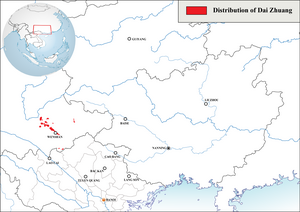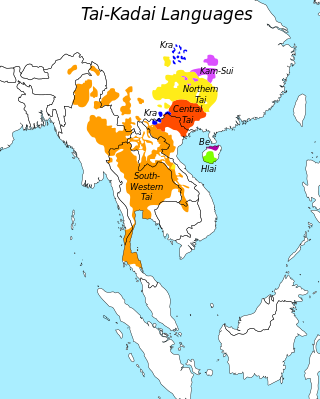
The term Kra–Dai peoples or Kra–Dai-speaking peoples refers collectively to the ethnic groups of southern China and Southeast Asia, stretching from Hainan to Northeast India and from southern Sichuan to Laos, Thailand and parts of Vietnam, who not only speak languages belonging to the Kra–Dai language family, but also share similar traditions, culture and ancestry.

The Dai people are several Tai-speaking ethnic groups living in the Xishuangbanna Dai Autonomous Prefecture and the Dehong Dai and Jingpo Autonomous Prefecture of China's Yunnan Province. The Dai people form one of the 56 ethnic groups officially recognized by the People's Republic of China. By extension, the term can apply to groups in Laos, Vietnam, Thailand and Myanmar when Dai is used to mean specifically Tai Yai, Lue, Chinese Shan, Tai Dam, Tai Khao or even Tai in general. For other names, please see the table below.
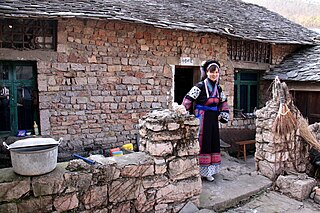
The Bouyei, otherwise known as the Zhongjia, are an ethnic group living in Southern Mainland China. Numbering 2.5 million, they are the 11th largest of the 56 ethnic groups officially recognized by the People's Republic of China.

The Zhuang languages are any of more than a dozen Tai languages spoken by the Zhuang people of Southern China in the province of Guangxi and adjacent parts of Yunnan and Guangdong. The Zhuang languages do not form a monophyletic linguistic unit, as northern and southern Zhuang languages are more closely related to other Tai languages than to each other. Northern Zhuang languages form a dialect continuum with Northern Tai varieties across the provincial border in Guizhou, which are designated as Bouyei, whereas Southern Zhuang languages form another dialect continuum with Central Tai varieties such as Nung, Tay and Caolan in Vietnam. Standard Zhuang is based on the Northern Zhuang dialect of Wuming.
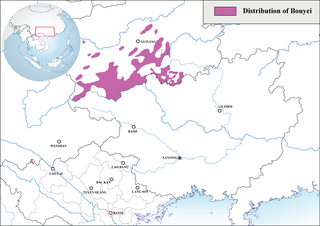
The Bouyei language is a language spoken by the Bouyei ethnic group of Southern Guizhou Province, China. Classified as a member of the Northern Tai group in the Tai language branch of the Tai–Kadai language family, the language has over 2.5 million native speakers and is also used by the Giay people in some parts of Vietnam. There are native speakers living in France or the United States as well, which emigrated from China or Vietnam. About 98% of the native speakers are in China.
Tai Dam, also known as Black Tai, is a Tai language spoken by the Tai Dam in Vietnam, Laos, Thailand, and China.

Wenshan Zhuang and Miao Autonomous Prefecture is an autonomous prefecture in southeastern Yunnan Province, People's Republic of China, and is the easternmost prefecture-level division of the province. It borders Baise, Guangxi, to the east, Vietnam's Hà Giang Province to the south for 438 kilometres (272 mi), Honghe Hani and Yi Autonomous Prefecture to the west, and Qujing to the north.
The Pula or Phù Lá are an ethnic group of Vietnam and China. Most Pula live in Xichou County and Maguan County of Wenshan Prefecture of Yunnan and the bordering Lào Cai Province of the Northeast region of Vietnam. Their population in Vietnam is 12,471 in 2019. There are also approximately 4,200 Phù Lá in China, where they are classified as members of the Yi ethnic group.
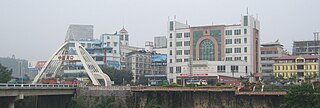
The Hekou Yao Autonomous County is an autonomous county in the southern part of the Yunnan province of China. It is part of the Honghe Hani and Yi Autonomous Prefecture and borders the northern Vietnamese city of Lào Cai. It was apparently known as Zhongcheng during the Tang dynasty.
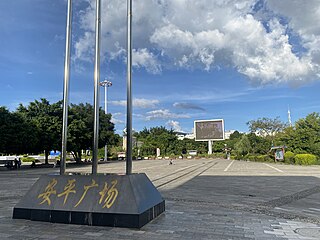
Maguan County is located in Wenshan Zhuang and Miao Autonomous Prefecture, Yunnan province, China, bordering Vietnam's Lào Cai and Ha Giang provinces to the south.

Qiubei County is under the administration of the Wenshan Zhuang and Miao Autonomous Prefecture, in southeast Yunnan province, China.
The Kra languages are a branch of the Kra–Dai language family spoken in southern China and in northern Vietnam.

Nong Zhuang is a Tai language spoken mainly in Wenshan Prefecture, Yunnan, China. In Wenshan Prefecture, it is spoken in Yanshan, Guangnan, Wenshan, Maguan, Funing, Xichou, and Malipo counties, and also in Honghe Prefecture and Vietnam. The heaviest concentrations relative to other Zhuang groups are in Xichou and Malipo counties.
The Lachi language is a Kra language spoken in Yunnan, China and in northern Vietnam. There were 9,500 Lachi speakers in Vietnam in 1990. Edmondson (2008) reports another 2,500 in Maguan County, Yunnan, China for 1995, but Li Yunbing (2000) reports 60 speakers in Maguan out of an ethnic population of 1,600.
Nùng is a Tai–Kadai language spoken mostly in Cao Bằng and Lạng Sơn provinces in Vietnam and also in China and Laos. It is also known as Nong, Tai Nùng, Tay, and Tày Nùng. Nùng is the name given to the various Tai languages of northern Vietnam that are spoken by peoples classified as Nùng by the Vietnamese government. The Nùng were originally Zhuang people who migrated into Vietnam in the 16th and 18th centuries.
Axi is one of the Loloish languages spoken by the Yi people of China. The Axi are one of the main linguistic sub-branches of Yi, and the Axi tiaoyue is a dance of the Axi speaking Yi people accompanied by the sanhu.
Tai Ya, also known as Tai Cung, Tai Chung and Dai Ya, is a Southwestern Tai language of southern China. It has one dialect, Tai Hongjin ; Red Tai.
Yei Zhuang is a Northern Tai language complex spoken in Wenshan Prefecture, Yunnan, China. Its speakers are also known as the Sha (沙族), a subgroup of the Zhuang.
Mantsi (autonym: ; also called Lô Lô, Flowery Lolo, White Lolo or Black Lolo, is a Lolo-Burmese language. Speakers are mostly located in Hà Giang Province, Vietnam. In China, speakers are classified as a subgroup of the Yi people. In Vietnam they are called Lô Lô and is classified as one of the official 54 ethnic groups in Vietnam.

The China–Vietnam border is the international boundary between China and Vietnam, consisting of a 1,297 km (806 mi) terrestrial border stretching from the tripoint with Laos in the west to the Gulf of Tonkin coast in the east, and a maritime border in the Gulf of Tonkin and South China Sea.
